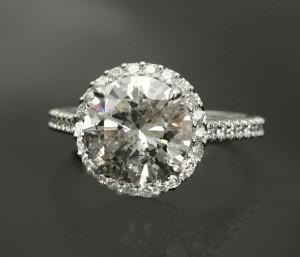–
 I’ve talked about diamond imperfections before, but let’s get into them deeper, so you really do understand them and how they affect your stone. First, a perfect diamond is few and far between, just like a perfect person is few and far between, although I do know many people who think they are perfect! Just like humans, diamonds possess a type of DNA, and each and every diamond is different.
I’ve talked about diamond imperfections before, but let’s get into them deeper, so you really do understand them and how they affect your stone. First, a perfect diamond is few and far between, just like a perfect person is few and far between, although I do know many people who think they are perfect! Just like humans, diamonds possess a type of DNA, and each and every diamond is different.
You can tell the differences in the diamonds by these diamond imperfections, or as I like to call them, perfections, because they make a diamond perfectly perfect! After all, these are flaws that add character, and with out these characteristics, no one would know their diamond from the next, so it isn’t about how many or what kind, but can you see them now.
Diamond Imperfections are Perfectly Acceptable
A diamond that is flawless, which is the GIA’s top clarity grade, is very rare. I can count the number of flawless diamonds I have seen on both hands. When you do see one, you look twice, thinking that perhaps your eyes are getting old or you are looking at a synthetic. It is a thing of beauty, but because it is so rare, it is also very expensive which is why diamond imperfections are perfectly acceptable.
Diamond Imperfections are Natural
Diamonds are crystals and are formed deep in the earth and when the there is an irregularity in the atomic structure or something gets into the carbon that doesn’t belong there an imperfection is born. This imperfection can come in many shapes and sizes and there can be many or a few. Sometimes they can be cut out when the rough stone is shaped and polished and sometimes they can’t, and that is when they become part of the personality of the diamond.
Diamond Imperfections the Criteria
There is a criterion, as far as grading your diamond imperfection perfections. The GIA classifies clarity by Flawless, Internally Flawless, Very Very Slightly Included, Very Slightly Included and Included. There are 2 categories of VVS and VS and 3 categories of I. The factors that determine the clarity grade are the size of the imperfections, the number, the position, the nature and the relief.
Basically, the more there are and the bigger they are and the easier they are to see the lower the grade.
Diamond Imperfections can you see them now?
One thing that a lot of people freak out about when they are buying a diamond is the clarity or the imperfections in their diamonds. Imperfections can be good because, as I said earlier, this is what sets your diamond apart from everyone else’s diamond. It’s your diamonds fingerprint or DNA. When you tell a person that the stone they are looking at has a clarity grade of VS2, which means that there are some pinpoint inclusions within the stone, but you can’t see them unless you are looking through a loupe, I get those that are okay with it and those that get scared by it.
There are times when you can hide those inclusions that can only be seen by a loupe under a prong, where you still won’t be able to see them with your naked eye, and there are times when you won’t be able to hide them under a prong. Either way, if you can only see them with a loupe, you won’t be able to see them with just your eyes. Even if you wear glasses. No matter how hard you look. I swear. Unless your stone is an I1, I2 or I3.
So, it’s kind of like that riddle…
If a tree falls in a forest, does anybody hear it fall? Will anybody know the clarity of your diamond if they can’t see the diamond imperfections?
